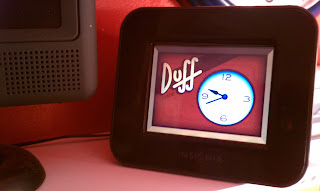 |
| The Insignia Infocast 3.5 by Best Buy (similar to the Chumby One). |
It's hard to remember, but back in 2008, there was not much out there like the Chumby. The iPhone and Android operating systems were relatively new and still gaining traction. There were zero consumer grade tablets available on the market. Even with the iPhone and Android out there, they were geared towards phone devices. There were definitely no clock radio gadgets to compete with Chumby. So theoretically, the Chumby had a good chance to succeed.
The Chumby is not a tablet and it is not a phone or iPod-like device. It really has no equivalent out there in the world. It is first and foremost an internet clock radio. Think of your old Sony Dream Machine, add in the likes of Pandora and Shoutcast internet music and podcast services, and add the ability to change the clock face to one of hundreds of different options. That is a Chumby.
There are other things a Chumby can do, like display news feeds, Facebook, Twitter, internet web cams, and more. Yet at its core, the Chumby is a clock radio that can get live content from the internet.
 |
| My boys really enjoy the Sony Dash. We have it in our dining room. |
I got my first "Chumby" in 2010 when I picked up a Sony Dash for a relatively good price. However, even though I got a "deal" at the time, price was one of Chumby's downfalls: the Dash list price was $200 at the time--I think I got my for a "steep discount" at $150--and the Chumby-branded units were not much cheaper.
The Dash was a step up from the Chumby, as it had internet video as well. You could (and can still) get Netflix, YouTube and Hulu Plus video, among other choices. So it was worth a slight premium over the much smaller Chumby One (3.5" screen vs. 7" screen), but still a bit expensive for what you got.
 |
| We have installed the Insignia Infocast 3.5 in our master bathroom media station. |
Alas, regular prices didn't get much lower than $100, most people didn't understand why they needed one in addition to their iPhones and iPads, and therefore not many units were sold. In 2011 Sony stopped making the Dash. Around that time Best Buy also stopped making the Infocast line. Later in the year, Chumby itself stopped making hardware as well, leaving the Chumby platform flailing around a little bit without much support. The company said they were going to focus on a connected TV platform, but nothing much came of it.
Just the other day, Chumby announced that the whole team had moved on to new things at Technicolor and that there was no one left at Chumby to turn the lights off.
The Chumby network is still up and running--for now--but much like what happened to services like ReplayTV, it could be shut off at any time. This leads to one of my ongoing concerns with this particular platform: it is 100% dependent on having a network connection to work at all. Without a WiFi or optional Ethernet connection, a Chumby is essentially worthless. There isn't even a way to boot up a Chumby in to a disconnected mode. The thing just stops at the "Connecting to Network" screen and gives up.
(As an aside, there are some ways to run some Chumby devices offline. One example is: Zurk's Chumby One/Infocast 3.5 firmware and Zurk's Infocast/Chumby 8 firmware.)
Another issue was the app platform: all Chumby apps were free and had to be build on the Adobe Flash platform. While that worked well enough for the most part, there are two issues with it: no way for developers to make any money, and somewhat limiting of a platform. The Chumby is based on a modified Linux kernel, but won't run regular Linux or Android apps without major modifications. So it's a relatively closed platform.
I guess even back in 2008 we could see the writing on the wall, but I still had high hopes that a device dedicated to being an internet clock radio could survive. I still think there is a place for a Chumby-like device, with some tweaks to the platform. Using a phone or tablet as a stationary clock or radio is not always practical or economical. Sure, as an individual I can use my Android phone as an alarm or an iPad as a Pandora music player, but what about family or group situations? Sometimes a dedicated device is useful.
Maybe something else will come about to take Chumby's place? Or Chumby will get picked up by another company and the legacy will continue? I can only hope.
UPDATE: Chumby is dead. Long live Chumby!



